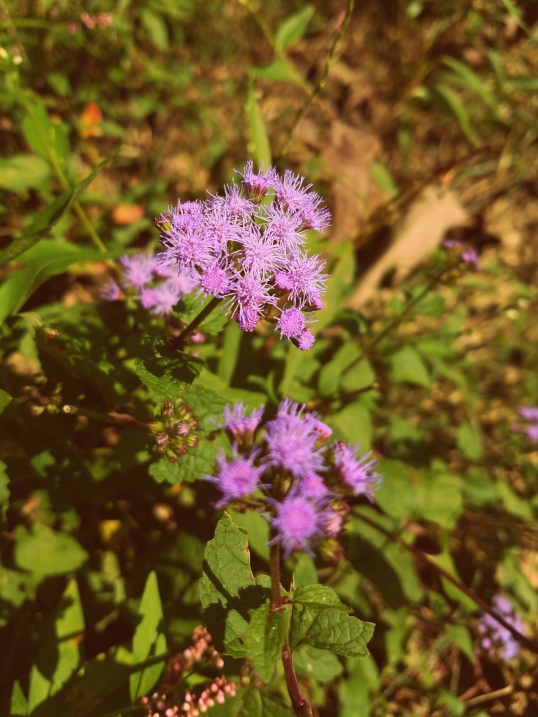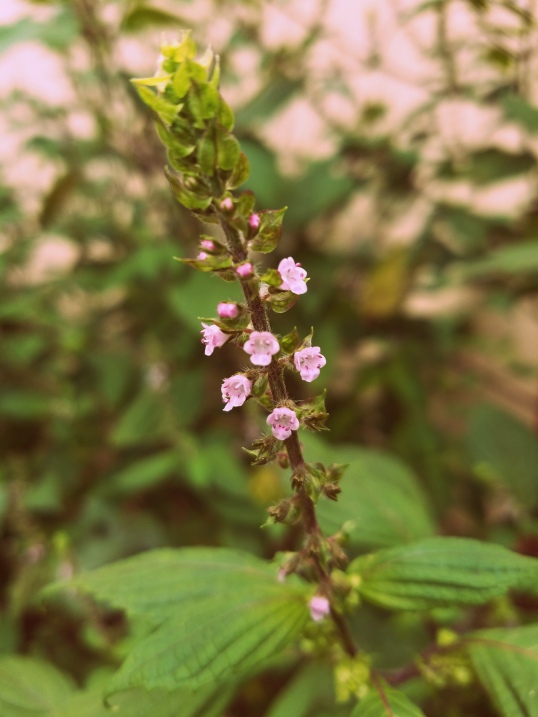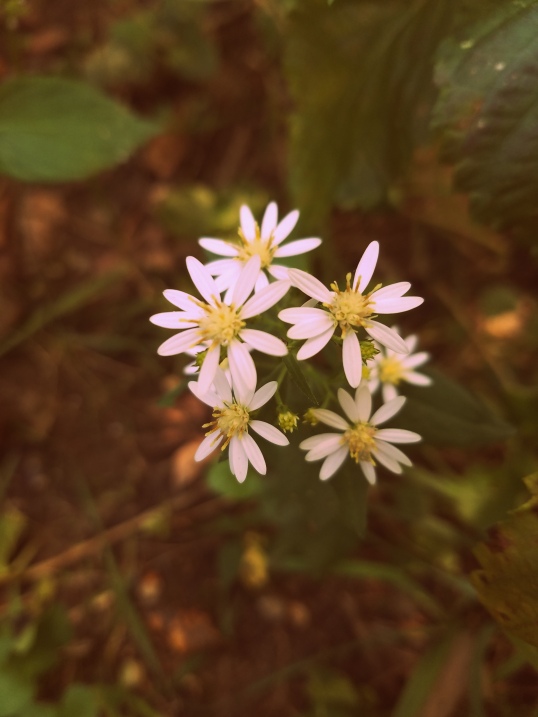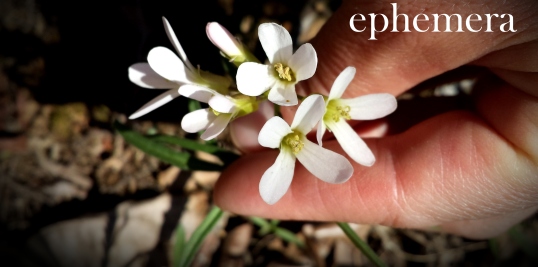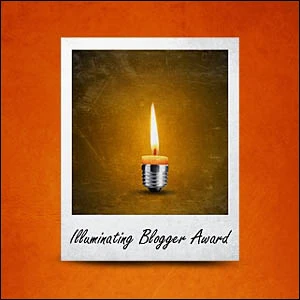I did not learn how to drive a tractor when I was growing up on the farm. That omission seems strange to me now, although I must admit that as a kid I was incredibly relieved that it never came up. Driving the tractor was something my brothers did. I used a shovel. I pushed a wheelbarrow. I carried buckets. I didn’t drive the tractors. I was afraid of them. Still am, frankly. What with all the gears and levers and noise and…parts. I mean, really. What the hell is a clevis tongue? Who can even say ‘clevis tongue’ with a straight face?
Now here I am decades later, back on the farm, and it is my turn to drive the tractor. As my dad succinctly put it, I need to know how to do this. No arguing that point. It’s easy to think about things. This is where I must actualize.
Let me introduce you to the Kubota, vehicle of my burgeoning farm skills. Grab a drink, I’ll tell you what I’ve learned so far. We have a larger tractor, simply called The Big Tractor. It’s a Ford, and it’s blue and has racing stripes like my tattoo. I’m sure that’s a coincidence. He’s almost as old as I am. I do not know how to drive The Big Tractor. Yet. That lesson is looming large around a nearby corner. The Kubota, however, is easy to drive once you get your hand-foot coordination going, and once all of the completely illogical knobs and levers have been thoroughly explained and their accompanying pictographs translated. It’s set up pretty much like any manual transmission: gas (in this case a throttle–both hand lever and foot pedal), brakes (left and right, independent or locked together), gear shift (forward, neutral, reverse), and a clutch. It also has something called a Glide-shift which allows the driver to shift gears (ie, speeds) without engaging the clutch or braking. This is particularly important because the clutch also controls the PTO drive shaft for all the useful things that attach to the back end of the tractor. In this case, the brush hog. Which is also called a bush hog. Potato, tomahto.
We have a larger tractor, simply called The Big Tractor. It’s a Ford, and it’s blue and has racing stripes like my tattoo. I’m sure that’s a coincidence. He’s almost as old as I am. I do not know how to drive The Big Tractor. Yet. That lesson is looming large around a nearby corner. The Kubota, however, is easy to drive once you get your hand-foot coordination going, and once all of the completely illogical knobs and levers have been thoroughly explained and their accompanying pictographs translated. It’s set up pretty much like any manual transmission: gas (in this case a throttle–both hand lever and foot pedal), brakes (left and right, independent or locked together), gear shift (forward, neutral, reverse), and a clutch. It also has something called a Glide-shift which allows the driver to shift gears (ie, speeds) without engaging the clutch or braking. This is particularly important because the clutch also controls the PTO drive shaft for all the useful things that attach to the back end of the tractor. In this case, the brush hog. Which is also called a bush hog. Potato, tomahto.
A brush hog is used to mow down brush, heavy weeds, and tall grass. It’s pretty impressive what it will chop down. Like my nemesis, the multiflora rose. Die, multiflora, die! When the clutch is engaged, the drive shaft (which runs the mower), stops spinning. The Glide-shift allows the driver to switch gears clutchlessly on the fly while keeping the mower running. Handy.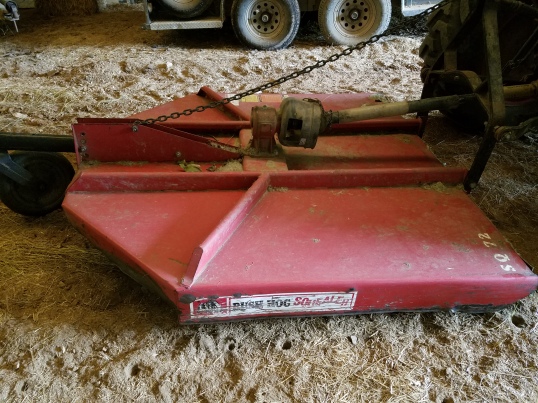 The project for the day was brush hogging a pasture on the northern end of the property. As you can see below, it is madly grown up with broom sage, a native warm-season grass that, except in its early growth, is not very good forage. Broom sage grows well on poor soils, which is why it is found in lush abundance in southern Missouri–where the soil is nothing but clay and rocks on top of more clay and considerably more rocks. It is a clear indicator that this pasture is in need of nutrients–most likely phosphorus–and also a pH shift. We’ll find out more next month when I start sending in soil samples to the local extension.
The project for the day was brush hogging a pasture on the northern end of the property. As you can see below, it is madly grown up with broom sage, a native warm-season grass that, except in its early growth, is not very good forage. Broom sage grows well on poor soils, which is why it is found in lush abundance in southern Missouri–where the soil is nothing but clay and rocks on top of more clay and considerably more rocks. It is a clear indicator that this pasture is in need of nutrients–most likely phosphorus–and also a pH shift. We’ll find out more next month when I start sending in soil samples to the local extension.
This broom sage is very tall. FYI, it should never get this tall. This is what happens when you should have brush hogged two months ago, but roughly 80 other things were further up the master To-Do list. Nothing will eat this grass. It does have other uses. It provides cover for quail (I saw 6 of them) and other wildlife. The sheep LOVE to hide in it. And doesn’t that make finding them fun? They think so. Once the engine is revved to the correct RPM to run the PTO (there’s a little unmarked arrow on the tachometer to let you know), you can engage the PTO (there’s a knob-thingie with hieroglyphics) and start mowing. Easy. You have to make sure to overlap just a little bit so that you don’t get a stripe of unmown grass between passes–especially since the giant back tires push quite a bit of it down. Then it’s just back and forth around the field. For hours and hours. Mowing down great swaths of tall grass. If you are like me, and you’ve learned to embrace your OCD, this is a rather pleasant job.
Once the engine is revved to the correct RPM to run the PTO (there’s a little unmarked arrow on the tachometer to let you know), you can engage the PTO (there’s a knob-thingie with hieroglyphics) and start mowing. Easy. You have to make sure to overlap just a little bit so that you don’t get a stripe of unmown grass between passes–especially since the giant back tires push quite a bit of it down. Then it’s just back and forth around the field. For hours and hours. Mowing down great swaths of tall grass. If you are like me, and you’ve learned to embrace your OCD, this is a rather pleasant job. Or it is until you hear a bad ruckus (as opposed to the good ruckus that indicates everything’s functioning properly) and look behind you to find the brush hog bumping along, listing badly to one side of the tractor. WTH? So you stop the tractor, engage the dual brake, put everything in neutral, disengage the PTO, throttle-down, drop the front bucket, turn the tractor off. Go investigate… Ah. A bolt is missing. The important kind that holds parts together. In this case, a bolt that holds one whole side of the brush hog on the tractor. So you walk from the very top of the pasture–because that’s where tractors break down–to the barn to find your dad. Because he knows how to fix everything, and you don’t. Well, I don’t. So I got my dad, and he got replacement bolts (which he, of course, had on hand in an old coffee canister on his workbench) and a couple ginormous wrenches that looked like they came from an A-ha video, and we fixed the brush hog.
Or it is until you hear a bad ruckus (as opposed to the good ruckus that indicates everything’s functioning properly) and look behind you to find the brush hog bumping along, listing badly to one side of the tractor. WTH? So you stop the tractor, engage the dual brake, put everything in neutral, disengage the PTO, throttle-down, drop the front bucket, turn the tractor off. Go investigate… Ah. A bolt is missing. The important kind that holds parts together. In this case, a bolt that holds one whole side of the brush hog on the tractor. So you walk from the very top of the pasture–because that’s where tractors break down–to the barn to find your dad. Because he knows how to fix everything, and you don’t. Well, I don’t. So I got my dad, and he got replacement bolts (which he, of course, had on hand in an old coffee canister on his workbench) and a couple ginormous wrenches that looked like they came from an A-ha video, and we fixed the brush hog.
Below, you can see the kind of bolty-nutty-lock pin situation I’m talking about. It attaches the brush hog to the tractor. This one is the bolt that was still holding the brush hog on the left-side lift arm. 1) Quick-release lock pin which holds the bolt on one side 2) Lift arm ball joint from the tractor 3) Brush hog left-side bar 4) Nut holding the right side of the bolt. What probably happened is that the nut fell off, and the bolt jiggled loose and fell out somewhere in the field. Maybe someday someone will find it and ask themselves what it is and how it got there. I have found many rusted old things on the farm like that, and I wonder these things, too. Here is the newly replaced bolt/nut/quick-release lock pin. Exciting, isn’t it? It made my day, let me tell you. On a farm, fixed things that work right are fucking fantastic. I am not upset that this broke. These are the lessons I need. And I am very fortunate to be able to learn so much from my dad now. I am constantly in awe of the fact that not only does he know what all this stuff is, but that he knows how to fix all of it. I feel the weight of that knowledge and know that my shoulders are not yet up to holding it. One lesson at a time.
Here is the newly replaced bolt/nut/quick-release lock pin. Exciting, isn’t it? It made my day, let me tell you. On a farm, fixed things that work right are fucking fantastic. I am not upset that this broke. These are the lessons I need. And I am very fortunate to be able to learn so much from my dad now. I am constantly in awe of the fact that not only does he know what all this stuff is, but that he knows how to fix all of it. I feel the weight of that knowledge and know that my shoulders are not yet up to holding it. One lesson at a time. All fixed. Back to brush hogging. I had a moment while on the tractor, about 3 hours in, where I realized that I could happily do this for the rest of my life. Not brush hogging specifically, although I wouldn’t mind that, but rather this whole tending the land thing; having my days measured out not by the clock, but by what needs to be done on that day, in that season. This was a good realization to have, seeing as how it’s kind of what I’m here to do. Affirmation by actualization.
All fixed. Back to brush hogging. I had a moment while on the tractor, about 3 hours in, where I realized that I could happily do this for the rest of my life. Not brush hogging specifically, although I wouldn’t mind that, but rather this whole tending the land thing; having my days measured out not by the clock, but by what needs to be done on that day, in that season. This was a good realization to have, seeing as how it’s kind of what I’m here to do. Affirmation by actualization.
And look at this–my brush hogging skillz? Better than decent. Not only did I miss all the bigass rocks in the section I did, but I (softie that I am) was even able to save this baby goldenrod that really wanted to grow in this spot. Because tending the land means many kinds of actions for all the life there. That’s a lesson I’m learning, too.
 Purple-headed sneezeweed (Helenium flexuosum)
Purple-headed sneezeweed (Helenium flexuosum)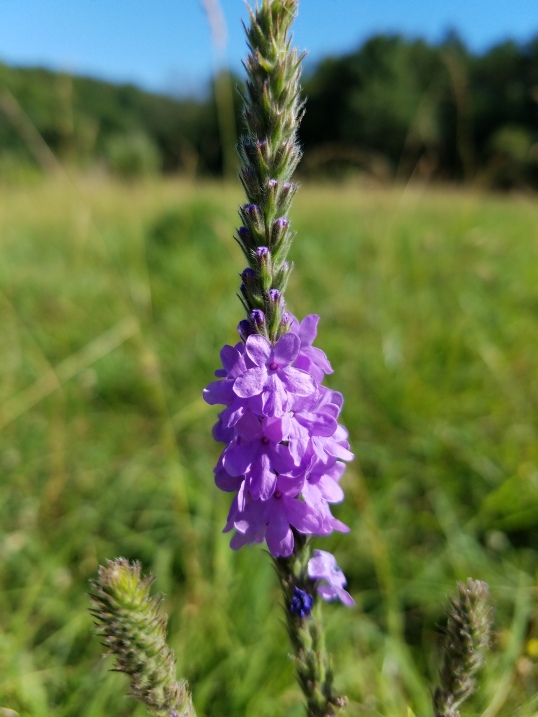 Blue vervain (Verbena hastata)
Blue vervain (Verbena hastata)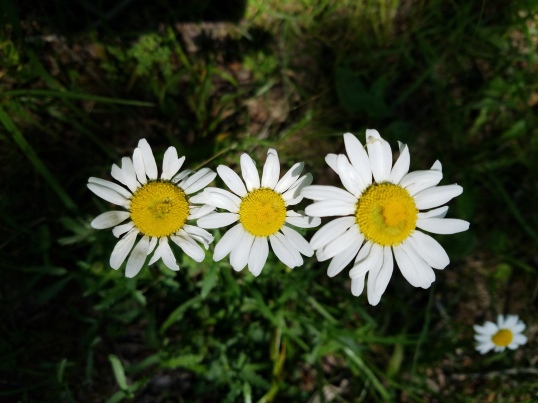 Ox-eye daisy (Leucanthemum vulgare)
Ox-eye daisy (Leucanthemum vulgare) Venus’ Looking Glass (Triodanis perfoliata)
Venus’ Looking Glass (Triodanis perfoliata) Goldenseal (Hydrastatis canadensis)
Goldenseal (Hydrastatis canadensis)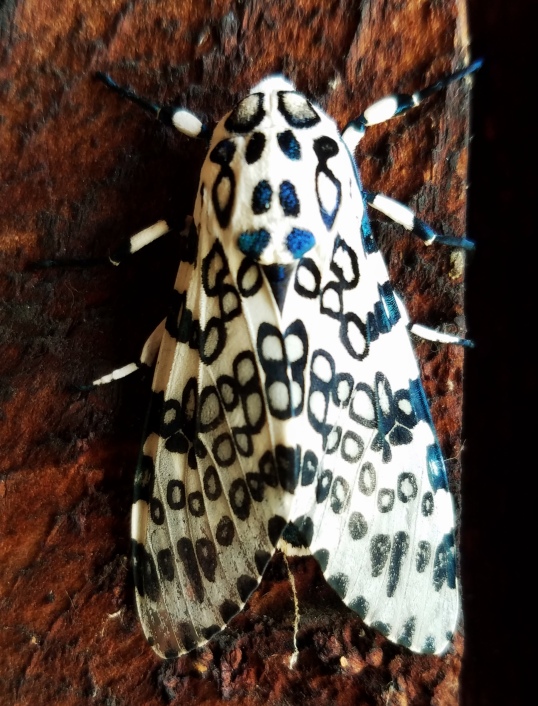
 Rudbeckia (probably) missouriensis: Black-eyed Susan
Rudbeckia (probably) missouriensis: Black-eyed Susan Ruellia humilis: Hairy Wild Petunia
Ruellia humilis: Hairy Wild Petunia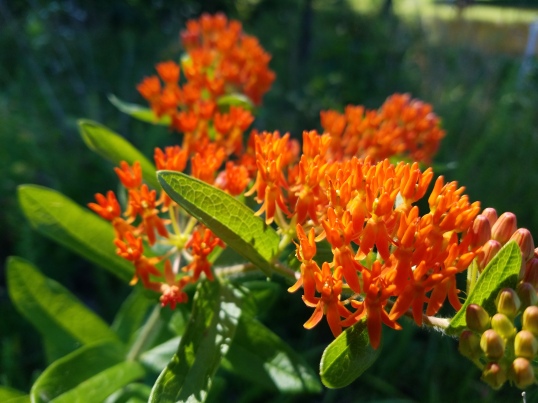 Asclepias tuberosa: Butterfly Weed
Asclepias tuberosa: Butterfly Weed Arisaema dracontium: The Green Dragon
Arisaema dracontium: The Green Dragon Achillea millefolium: Yarrow
Achillea millefolium: Yarrow Dianthus armeria: Deptford Pink
Dianthus armeria: Deptford Pink A dragonfly that’s as big as my hand! I believe this odonata is known as a common sanddragon. I don’t think there is anything common about him.
A dragonfly that’s as big as my hand! I believe this odonata is known as a common sanddragon. I don’t think there is anything common about him. She looks demure now. This is right before she jumped for my face.
She looks demure now. This is right before she jumped for my face. A bit of big-for-me news: Today was my first day on the farm as a full-time farmer. Farmhand. Person who gets to look at sheep all day. On Thursday, after I clocked out from my last day at my former for realz job, I wrote the following to some friends:
A bit of big-for-me news: Today was my first day on the farm as a full-time farmer. Farmhand. Person who gets to look at sheep all day. On Thursday, after I clocked out from my last day at my former for realz job, I wrote the following to some friends: Those words echoed in my head all day today. They were true when I wrote them, as the brave words of the earnest and hopeful often are. And after cutting exactly 600 sections of wire for a fencing project today, my hands were most definitely calloused—but my heart was anything but calm. It beat in my chest soft and unsure like a baby bird. Yet also light, despite the weight of the task we’ve taken on. That surprised me. Although now as I contemplate this feeling, I think that must be the blessing of knowing that you are doing the right thing–even when you don’t know what you’re doing.
Those words echoed in my head all day today. They were true when I wrote them, as the brave words of the earnest and hopeful often are. And after cutting exactly 600 sections of wire for a fencing project today, my hands were most definitely calloused—but my heart was anything but calm. It beat in my chest soft and unsure like a baby bird. Yet also light, despite the weight of the task we’ve taken on. That surprised me. Although now as I contemplate this feeling, I think that must be the blessing of knowing that you are doing the right thing–even when you don’t know what you’re doing. This is the approach I took today. When it seemed to much, I held that baby bird up in my hands and showed it the view and said, This isn’t going anywhere. It has been here for a billion years without you. It will be here for a billion more without you. Be here now, and make it count. Work slowly, slowly. There is time to figure this all out. So the day went, with me figuring things out slowly, slowly; and slowly, slowly my heart began to calm, to take in the view, and to beat steady and true. And a little bit wilder than before.
This is the approach I took today. When it seemed to much, I held that baby bird up in my hands and showed it the view and said, This isn’t going anywhere. It has been here for a billion years without you. It will be here for a billion more without you. Be here now, and make it count. Work slowly, slowly. There is time to figure this all out. So the day went, with me figuring things out slowly, slowly; and slowly, slowly my heart began to calm, to take in the view, and to beat steady and true. And a little bit wilder than before. Now that my days are governed by things other than punching in clocks, look for more about life on the farm and also about dyeing, as the dyepots are soon to be brought out of storage. That is all for now. You will soon have your fill of fence-building and compost-making and sheep-herding and tractor-repairing and garden-planting and yarn-dyeing. Ah, who are we kidding? There is never enough yarn dyeing.
Now that my days are governed by things other than punching in clocks, look for more about life on the farm and also about dyeing, as the dyepots are soon to be brought out of storage. That is all for now. You will soon have your fill of fence-building and compost-making and sheep-herding and tractor-repairing and garden-planting and yarn-dyeing. Ah, who are we kidding? There is never enough yarn dyeing.



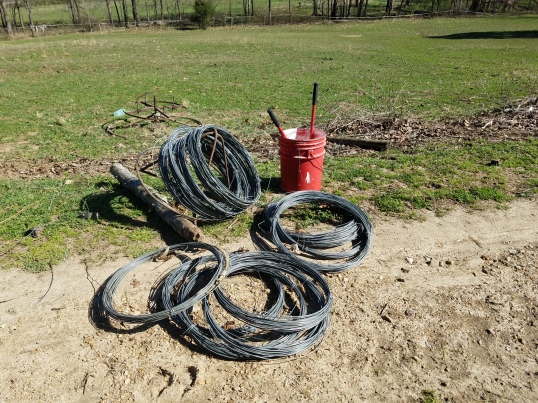





 What? Fortitude, mostly. It’s a lot of garter stitch. 280 stitches per row. 472 rows. That’s 132,160 stitches just on the body. Add maybe another thousand or so for the neck. At times, it felt like a million more than that. It was the neverending story. But as far as stories go, it was a lovely one to listen to and to create. Warm, soft, lustrous, and colourful. It was these qualities that kept me coming back to the knitting. It was so enjoyable. I stopped seeing garter stitch as ‘basic’, and started to experience it for what it truly is–foundational. And the ruana, safe and constant, gave me space to think.
What? Fortitude, mostly. It’s a lot of garter stitch. 280 stitches per row. 472 rows. That’s 132,160 stitches just on the body. Add maybe another thousand or so for the neck. At times, it felt like a million more than that. It was the neverending story. But as far as stories go, it was a lovely one to listen to and to create. Warm, soft, lustrous, and colourful. It was these qualities that kept me coming back to the knitting. It was so enjoyable. I stopped seeing garter stitch as ‘basic’, and started to experience it for what it truly is–foundational. And the ruana, safe and constant, gave me space to think. And like the best stories, the ones that are unhurried, that take time to pause and call attention as they turn and unfold and build, the ruana demanded patience and rewarded with depth. Demanded reflection and rewarded with insight. She holds a story. Each stitch a word, each row a phrase flowing into the next; the wool providing both characters and setting, my hands the action. My own story knit into it whole cloth.
And like the best stories, the ones that are unhurried, that take time to pause and call attention as they turn and unfold and build, the ruana demanded patience and rewarded with depth. Demanded reflection and rewarded with insight. She holds a story. Each stitch a word, each row a phrase flowing into the next; the wool providing both characters and setting, my hands the action. My own story knit into it whole cloth. One of the joys of this project was playing with so many different, glorious skeins of yarn. I loved choosing at random (which is never really random) and seeing how each colour blended into the next. Each skein had its own personality, and I’ll say this: you have to listen to your yarn. It will tell you who it wants to sit next to, if it wants to stand out or blend in.
One of the joys of this project was playing with so many different, glorious skeins of yarn. I loved choosing at random (which is never really random) and seeing how each colour blended into the next. Each skein had its own personality, and I’ll say this: you have to listen to your yarn. It will tell you who it wants to sit next to, if it wants to stand out or blend in.
 We have a larger tractor, simply called The Big Tractor. It’s a Ford, and it’s blue and has racing stripes like my tattoo. I’m sure that’s a coincidence. He’s almost as old as I am. I do not know how to drive The Big Tractor. Yet. That lesson is looming large around a nearby corner. The Kubota, however, is easy to drive once you get your hand-foot coordination going, and once all of the completely illogical knobs and levers have been thoroughly explained and their accompanying pictographs translated. It’s set up pretty much like any manual transmission: gas (in this case a throttle–both hand lever and foot pedal), brakes (left and right, independent or locked together), gear shift (forward, neutral, reverse), and a clutch. It also has something called a Glide-shift which allows the driver to shift gears (ie, speeds) without engaging the clutch or braking. This is particularly important because the clutch also controls the PTO drive shaft for all the useful things that attach to the back end of the tractor. In this case, the brush hog. Which is also called a bush hog. Potato, tomahto.
We have a larger tractor, simply called The Big Tractor. It’s a Ford, and it’s blue and has racing stripes like my tattoo. I’m sure that’s a coincidence. He’s almost as old as I am. I do not know how to drive The Big Tractor. Yet. That lesson is looming large around a nearby corner. The Kubota, however, is easy to drive once you get your hand-foot coordination going, and once all of the completely illogical knobs and levers have been thoroughly explained and their accompanying pictographs translated. It’s set up pretty much like any manual transmission: gas (in this case a throttle–both hand lever and foot pedal), brakes (left and right, independent or locked together), gear shift (forward, neutral, reverse), and a clutch. It also has something called a Glide-shift which allows the driver to shift gears (ie, speeds) without engaging the clutch or braking. This is particularly important because the clutch also controls the PTO drive shaft for all the useful things that attach to the back end of the tractor. In this case, the brush hog. Which is also called a bush hog. Potato, tomahto. The project for the day was brush hogging a pasture on the northern end of the property. As you can see below, it is madly grown up with
The project for the day was brush hogging a pasture on the northern end of the property. As you can see below, it is madly grown up with  Once the engine is revved to the correct RPM to run the PTO (there’s a little unmarked arrow on the tachometer to let you know), you can engage the PTO (there’s a knob-thingie with hieroglyphics) and start mowing. Easy. You have to make sure to overlap just a little bit so that you don’t get a stripe of unmown grass between passes–especially since the giant back tires push quite a bit of it down. Then it’s just back and forth around the field. For hours and hours. Mowing down great swaths of tall grass. If you are like me, and you’ve learned to embrace your OCD, this is a rather pleasant job.
Once the engine is revved to the correct RPM to run the PTO (there’s a little unmarked arrow on the tachometer to let you know), you can engage the PTO (there’s a knob-thingie with hieroglyphics) and start mowing. Easy. You have to make sure to overlap just a little bit so that you don’t get a stripe of unmown grass between passes–especially since the giant back tires push quite a bit of it down. Then it’s just back and forth around the field. For hours and hours. Mowing down great swaths of tall grass. If you are like me, and you’ve learned to embrace your OCD, this is a rather pleasant job. Or it is until you hear a bad ruckus (as opposed to the good ruckus that indicates everything’s functioning properly) and look behind you to find the brush hog bumping along, listing badly to one side of the tractor. WTH? So you stop the tractor, engage the dual brake, put everything in neutral, disengage the PTO, throttle-down, drop the front bucket, turn the tractor off. Go investigate… Ah. A bolt is missing. The important kind that holds parts together. In this case, a bolt that holds one whole side of the brush hog on the tractor. So you walk from the very top of the pasture–because that’s where tractors break down–to the barn to find your dad. Because he knows how to fix everything, and you don’t. Well, I don’t. So I got my dad, and he got replacement bolts (which he, of course, had on hand in an old coffee canister on his workbench) and a couple ginormous wrenches that looked like they came from an A-ha video, and we fixed the brush hog.
Or it is until you hear a bad ruckus (as opposed to the good ruckus that indicates everything’s functioning properly) and look behind you to find the brush hog bumping along, listing badly to one side of the tractor. WTH? So you stop the tractor, engage the dual brake, put everything in neutral, disengage the PTO, throttle-down, drop the front bucket, turn the tractor off. Go investigate… Ah. A bolt is missing. The important kind that holds parts together. In this case, a bolt that holds one whole side of the brush hog on the tractor. So you walk from the very top of the pasture–because that’s where tractors break down–to the barn to find your dad. Because he knows how to fix everything, and you don’t. Well, I don’t. So I got my dad, and he got replacement bolts (which he, of course, had on hand in an old coffee canister on his workbench) and a couple ginormous wrenches that looked like they came from an A-ha video, and we fixed the brush hog. Here is the newly replaced bolt/nut/quick-release lock pin. Exciting, isn’t it? It made my day, let me tell you. On a farm, fixed things that work right are fucking fantastic. I am not upset that this broke. These are the lessons I need. And I am very fortunate to be able to learn so much from my dad now. I am constantly in awe of the fact that not only does he know what all this stuff is, but that he knows how to fix all of it. I feel the weight of that knowledge and know that my shoulders are not yet up to holding it. One lesson at a time.
Here is the newly replaced bolt/nut/quick-release lock pin. Exciting, isn’t it? It made my day, let me tell you. On a farm, fixed things that work right are fucking fantastic. I am not upset that this broke. These are the lessons I need. And I am very fortunate to be able to learn so much from my dad now. I am constantly in awe of the fact that not only does he know what all this stuff is, but that he knows how to fix all of it. I feel the weight of that knowledge and know that my shoulders are not yet up to holding it. One lesson at a time. All fixed. Back to brush hogging. I had a moment while on the tractor, about 3 hours in, where I realized that I could happily do this for the rest of my life. Not brush hogging specifically, although I wouldn’t mind that, but rather this whole tending the land thing; having my days measured out not by the clock, but by what needs to be done on that day, in that season. This was a good realization to have, seeing as how it’s kind of what I’m here to do. Affirmation by actualization.
All fixed. Back to brush hogging. I had a moment while on the tractor, about 3 hours in, where I realized that I could happily do this for the rest of my life. Not brush hogging specifically, although I wouldn’t mind that, but rather this whole tending the land thing; having my days measured out not by the clock, but by what needs to be done on that day, in that season. This was a good realization to have, seeing as how it’s kind of what I’m here to do. Affirmation by actualization.

